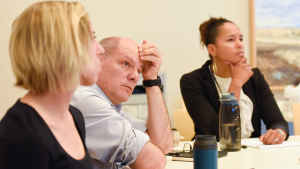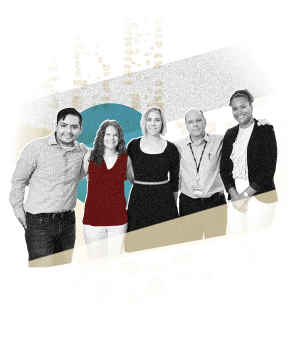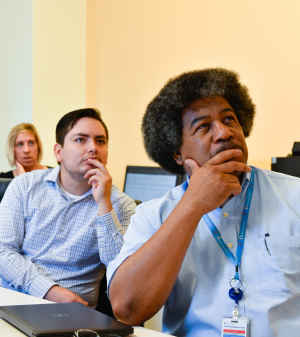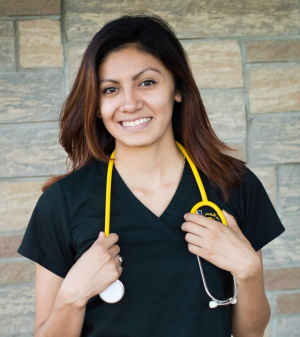
We’re in this together
Keeping our communities healthy
Audio plays during this story.

Neighbors helping neighbors
In Aurora, Colorado, there’s a 4-mile-long, 8-block stretch of East Colfax Avenue where the neighborhood housing is as diverse as its residents.
Century-old farmhouses, postwar brick cottages and dense midcentury apartment complexes share space with few trees and many parking lots. Its families hail from more than 130 countries, according to the local school district.
With its proximity to pollutants from major roads and industrial sites—coupled with indoor environmental factors like dust, mold, mildew, smoke and pet dander—the “Colfax Corridor,” as researchers call it, is a prime location to study a public health threat like asthma.
How to tackle that threat started, as some big ideas do, with a chance conversation.
About the Aurora residents who live just down the street from the CU Anschutz Medical Campus and who struggle to make ends meet.
About the community leaders concerned about the well-being of these neighbors who lack access to safe, stable and healthy housing.
About the need for research data that could help make a difference not only in the health of these households, but in grant funding and policy decisions.

Fernando Holguin, MD, is an asthma expert at CU who is leading the charge to find solutions to health problems affecting our most vulnerable populations. He is also training the next generation of leaders to address the health needs of our communities.
Donors’ gifts to CU are playing a major role in exploring these issues.

"I'm sort of a big believer that when the health of a community improves, we all gain. So I think it's something we should all be invested in."
Fernando Holguin, MD, a physician at UCHealth University of Colorado Hospital and director of the Colorado School of Public Health’s Latino Research and Policy Center

In 2018, Holguin and his peers in public health decided to see if research data could address what community organizations were worried about in Aurora: Were residents more at risk for sickness and disease because of their environment?
Holguin is partnering on a comprehensive and collaborative study with the Breathing Institute at Children’s Hospital Colorado and Colorado State University. Funded by Children’s Hospital Colorado, the study is part of a broader research and academic effort at CU to identify how health inequities are associated with social and economic disadvantages.

Road trip turned research
The study explores asthma cases among families who live along the Colfax Corridor, where economic disadvantages are prevalent—for instance, 68 percent of families qualify for free or reduced-cost lunch, according to local schools.

The researchers have relied on local schools, businesses and community organizations like the Colfax Community Network (CCN) to help recruit families to participate in the study.
Here, members of the research team volunteer to pack bags of snacks and hygiene products before doing street outreach with CCN along the Colfax Corridor.

"This is a project that came from the community. Because we are large institutions, because we have expertise in research, in medicine, we are able to tackle this problem from an angle and through a lens that our community partners would not have been able to."
Kate Johnston, a community health manager at Children’s Hospital Colorado

"To me, what's exciting about that is we are relying on our community partners to be successful. We could not do this project without them. They are gatekeepers; they are the knowledge holders."
Kate Johnston, Children's Hospital Colorado


Judith, who did not want her last name used, has lived in this garden-level apartment for eight years with her three children. She works as a house cleaner, cook and street vendor, and often she volunteers at her children’s schools and at a community clinic.
Judith and her family live within the Colfax Corridor.

The researchers collect data from households in many ways.

They give families new vacuum cleaners equipped with special filters to collect dust samples from their floors.

They ask individuals to breathe into a device called a spirometer, which measures lung function.

And they install air quality sensors in residences, be it a motel, apartment or house, which measure indoor air every minute for a week.

"We start to have these conversations about the social determinants of health. It's important because it's one of the key things, at least from a pulmonology perspective, from an asthma perspective, that we look at and say, ‘Hey, this is a huge trigger; what's going on for these families in these other areas as well?'"
Arthur McFarlane, right, a population health analyst at Children’s Hospital Colorado
Individual measures like these can help identify patterns about a community’s public health and reveal clues about larger issues like housing, transportation, education, employment, health care and health care utilization.
Public health issues are complex and interdisciplinary, and strong partnerships are crucial to developing solutions.

Ellison Carter is an environmental engineer and assistant professor at Colorado State University. She joined the study earlier this year.
While the medical professionals at CU Anschutz and Children’s Hospital Colorado study data points about emergency room visits and lung function, Carter is helping them understand the air these families breathe in their homes.

"We’re hoping to learn some information that would give us insight into the kinds of interventions we could propose in a larger study to mitigate the asthma exacerbation that those families experience. I think the more we do that the more likely we’re able to effectively serve the Colorado population and maybe even create models that could be applicable in other parts of the United States."
Ellison Carter, Colorado State University
Health inequities are differences in health that are closely linked with social, economic and environmental disadvantages. Disparities typically affect groups who have systematically experienced greater obstacles more so than the broader U.S. population, resulting in higher rates of disease and unnecessary costs that affect us all.
Improving health equity benefits the health of everyone.
The next generation of advocates
Bolstered by a donor’s generosity in 2014, CU Anschutz offers a certificate that educates students about health issues specific to the Latino community. As part of the certificate program, CU students work on projects that address a public health issue and help develop interventions. The first CU students to earn the certificate graduated in 2019.

Diana Albor is a nurse at a health clinic in Colorado Springs. Last year, she received a CU scholarship and plans to graduate with a master’s in public health next fall.

Albor, seen here with her parents, grew up in Kansas City watching her father struggle to manage his diabetes around the obstacles to health care, like the cost of insurance, language barriers and cultural differences that sometimes exist between a patient and physician.
She enrolled in the Latino health certificate program last year.

"I wanted to do something with my future where I knew I could give back to the community. That was something my parents instilled in me from a young age—giving back and helping those who need it."
Diana Albor, CU student

Holguin hopes the certificate program will continue to expand career and research opportunities for CU students. Many of the students have decided to continue their work on public health issues, from vaping to maternal health to obesity, after graduation.

These hands-on learning experiences help prepare the next generation of leaders of public health, impacting the health of our communities for generations to come.


